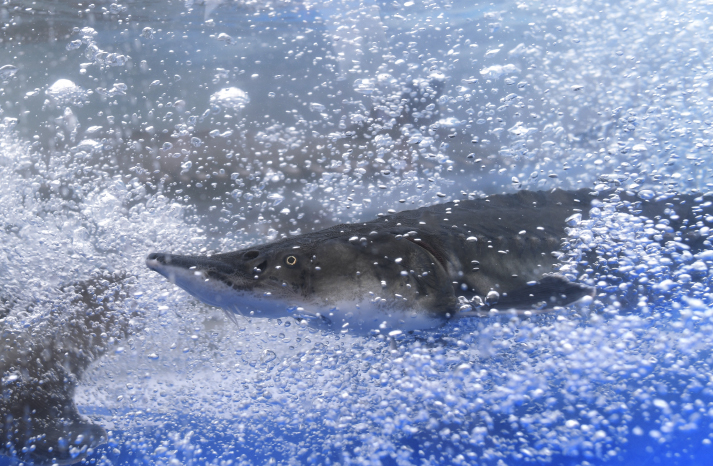|
||||||
|
||||||
| Home Nation World Business Opinion Lifestyle China Focus ChinAfrica Multimedia Columnists Documents Special Reports |
|
||||||
|
||||||
| Home Nation World Business Opinion Lifestyle China Focus ChinAfrica Multimedia Columnists Documents Special Reports |
| Nation |
| New Lease of Life for Living Fossils |
| Corporate initiative to protect the endangered Chinese sturgeon |
| By Li Nan · 2019-04-22 · Source: | NO.17 APRIL 25, 2019 |
 An artificially bred Chinese sturgeon (LI BIN)
On April 13, 700 Chinese sturgeons, known as "living fossils," were released into the Yangtze River in central China's Hubei Province to give a fresh lease of life to one of the oldest extant species dating back to 140 million years ago and once coexisting with dinosaurs. The Chinese sturgeon, a rare fish, is being bred artificially after efforts to protect the species started in the 1950s. "Unfortunately, the rare species in the Yangtze are becoming increasingly endangered as the water and ecology deteriorated due to human activities. No natural reproduction was seen in the Chinese sturgeon in the past two years," Zhao Yimin, an official of the Ministry of Agriculture and Rural Affairs, said. Zhao was speaking at the ceremony to release the fish in the Yangtze after they were bred by the Chinese Sturgeon Research Institute (CSRI), a research arm of China Three Gorges Corp. (CTGC).
Local residents learn more about the Chinese sturgeon in Yichang City, Hubei Province, on April 13 (LI NAN)
The CSRI was founded in 1982 to breed and protect the rare fish. More than 5 million artificially bred sturgeons have been released into the Yangtze River since 1984. Wang Dianchang, head of the CTGC's environmental protection department, said the CSRI has bred a complete community of sturgeons of different age groups, which enables the fish to reproduce without seeking wild partners. The newly released sturgeons are in five age groups, with the youngest 2 years and the oldest over 10 years. Researchers have fitted the fish with sonar tags, which can function for 10 years, to monitor their movements.  Volunteers release artificially bred Chinese sturgeons into the Yangtze in Yichang City, Hubei Province, on April 13, 2019 (LI NAN)
However, more efforts are needed. "The latest data shows that the number of wild sturgeons is still low. More efforts are needed to protect the sturgeon," Cao Wenxuan, an academician with the Chinese Academy of Sciences, said. In recent years, the Chinese Government has scaled up protection of the Yangtze and the species it is home to. This year, fishing was banned in the 332 aquatic reserves along the river. Next, a fund will be established for protecting the aquatic life in the Yangtze.  Seven hundred artificially bred Chinese sturgeons are released into the Yangtze River in Yichang, central China's Hubei Province, on April 13 (ZHOU XINGLIANG)
(Reporting from Yichang, Hubei Province) Comments to linan@bjreview.com |
About Us | Contact Us | Advertise with Us | Subscribe
|
||
| Copyright Beijing Review All rights reserved 京ICP备08005356号 京公网安备110102005860号 |